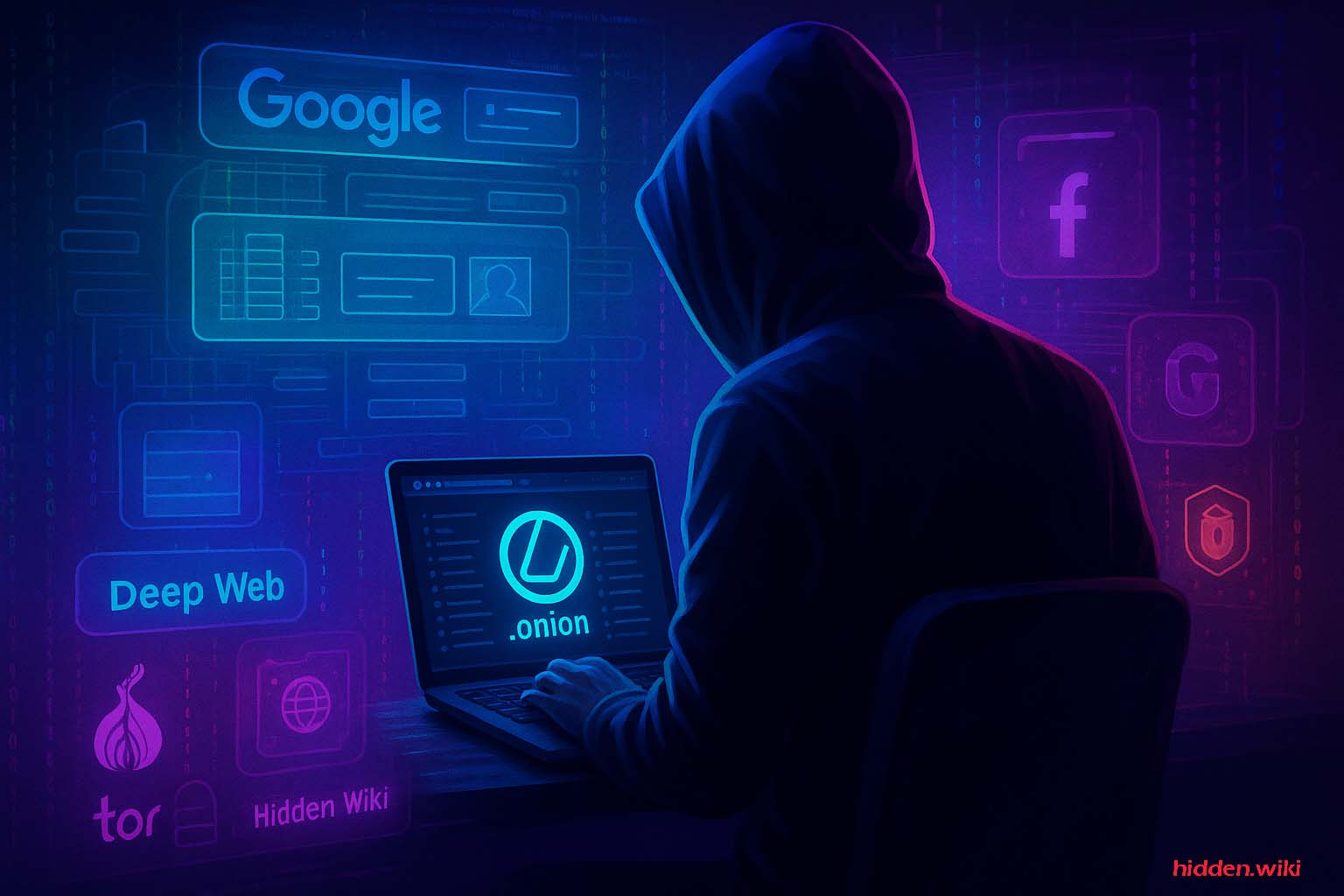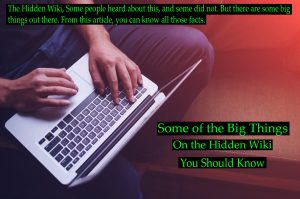🌐 What Are Dark Web Sites and Links in 2025?
In 2025, the terms “dark web links” and “dark web sites” have become more familiar to everyday internet users, but the concepts behind them are still widely misunderstood. To grasp what these terms mean, it’s important to distinguish between the surface web, the deep web, and the dark web.
The surface web refers to everything you can access using search engines like Google, Bing, or DuckDuckGo — think news sites, social media platforms, and blogs. The deep web includes content that isn’t indexed by search engines, such as private databases, academic journals, medical records, or anything behind a login page. The dark web, however, is a small, intentionally hidden part of the deep web that requires special tools like the Tor Browser to access.
From journalists to privacy enthusiasts, who uses the dark web the most might surprise you.
Dark web sites use a different kind of domain — the .onion extension — which doesn’t work on regular browsers. These .onion sites are hosted on the Tor network, which encrypts traffic and routes it through multiple nodes, making it extremely difficult to trace. This added layer of anonymity is what sets these links apart and is the reason so many seek out dark web links in the first place.
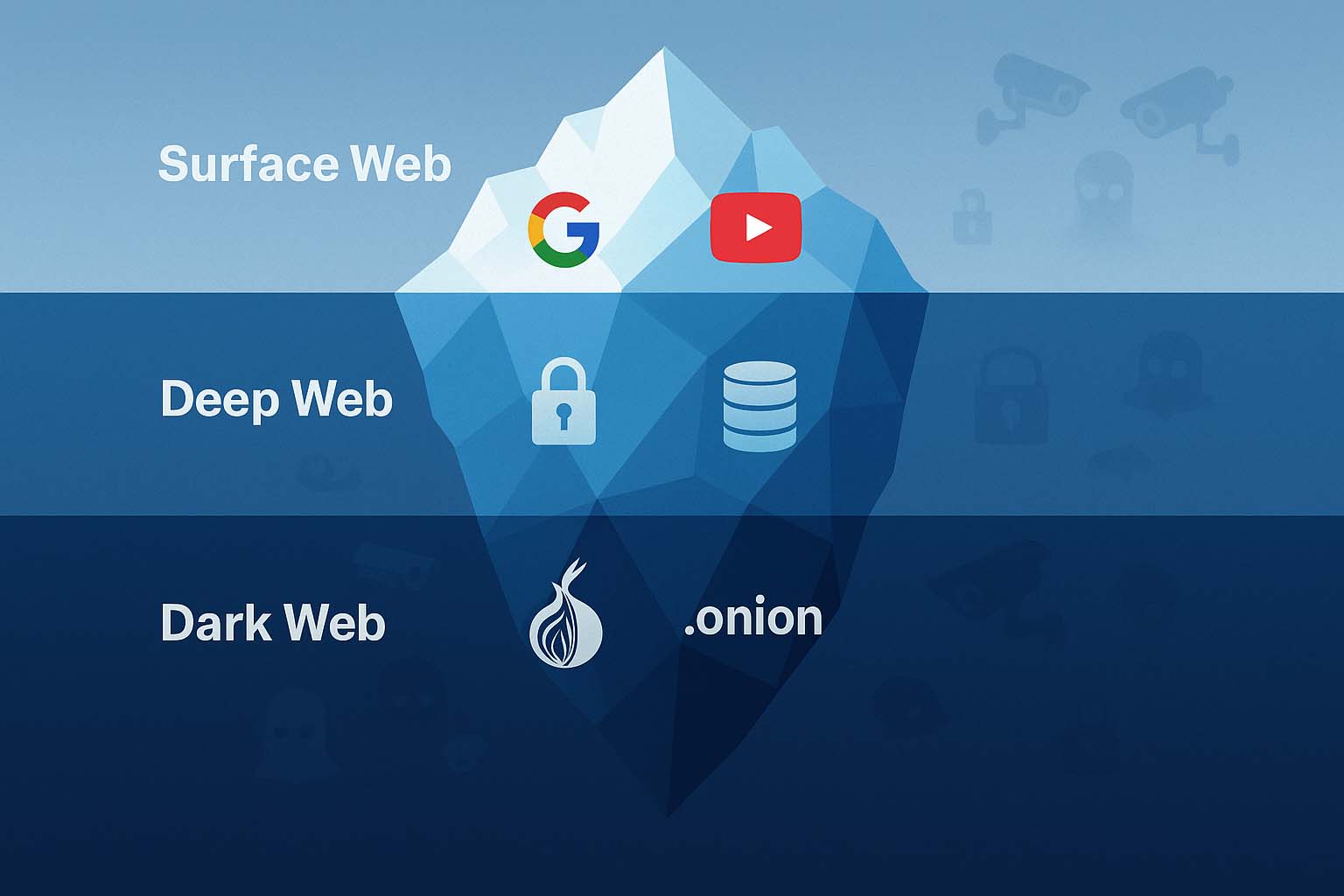
For users looking to preserve their privacy, knowing how to find real dark web links and access dark web sites that are safe in 2025 is essential. Whether through trusted onion directories or privacy search engines, journalists, whistleblowers, and ordinary users turn to the dark web for secure, censorship-free access to information. In an age of surveillance and data leaks, these hidden networks still offer something the surface web often can’t — freedom and anonymity.
💰 Bitcoin Mixers and Anonymous Wallets on the Dark Web
Cryptocurrency is essential to dark web transactions, but wallets and mixers carry risks. Many fake platforms exist purely to steal funds, so only a few services are still active in 2025. Here are some onion links often mentioned in directories — always verify before use.
- Onionwallet – An anonymous bitcoin wallet and mixer, often used to protect transaction history. Visit Onionwallet
- EasyCoin – A wallet and mixer designed for quick deposits and withdrawals. Access EasyCoin
- VirginBitcoins – Offers freshly mined, “clean” bitcoins that haven’t passed through other wallets. Go to VirginBitcoins
- Dark Mixer – A long-standing bitcoin mixing service for anonymizing transactions. Dark Mixer Link
- Mixabit – Another popular bitcoin mixer that helps obfuscate transaction trails. Mixabit Onion Site
⚠️ Disclaimer: Bitcoin mixers and anonymous wallets are high-risk. Many are scams or law enforcement traps. This list is for educational purposes only.
🛑 Other Dark Web Vendors (For Awareness Only)
While many dark websites provide forums, privacy tools, and whistleblowing platforms, there is also a large number of vendors that claim to sell highly controversial or outright illegal products and services. These sites often appear in onion directories, but they come with extreme risks. Many are scams designed to steal money, while others are honeypots monitored by law enforcement.
Below are some examples of vendors frequently mentioned across dark web listings. They are included here for awareness and educational purposes only — not as recommendations.
- Cardshop USA – A long-running vendor that advertises stolen credit card data and CVV numbers with “verified balance” claims.
Cardshop Onion Link - USACitizenship – A site claiming to sell fake U.S. citizenship packages and identity documents.
USACitizenship Onion Link - Counterfeit USD – Markets itself as a source for high-quality counterfeit U.S. bills. Such sites are notorious for scams.
Counterfeit USD Onion Link - Apples4Bitcoin – Advertises iPhones, iPads, and other Apple products in exchange for Bitcoin.
Apples4Bitcoin Onion Link - EuroGuns – A European vendor site claiming to sell firearms and ammunition.
EuroGuns Onion Link - Rent-A-Hacker – A so-called hacker-for-hire service that appears across multiple directories. Most listings of this kind are fake.
Rent-A-Hacker Onion Link - AccMarket – Claims to sell premium PayPal, eBay, and even bank account credentials.
AccMarket Onion Link - Onion Identity Services – Offers counterfeit passports and fake ID cards for Bitcoin.
Onion Identity Services Link
⚠️ Important Note: Nearly all “vendor” onion sites are scams, clones, or traps. Sending cryptocurrency to them is a high-risk move that almost always results in loss. This section is included only to demonstrate the types of listings that circulate on the dark web. Always treat such sites with extreme skepticism.
🛡️ How to Access Trusted Dark Web Sites Safely in 2025
Accessing dark web sites isn’t hard, but doing it safely requires the right tools and awareness of common threats. The most important tool is the Tor Browser, which lets users access .onion domains by routing traffic through a decentralized, encrypted network, making it extremely difficult to trace.
To boost anonymity, many users connect to Tor through a VPN, which hides Tor usage from their internet provider. For stronger protection, consider using Tails OS, a privacy-focused operating system that runs from a USB and leaves no trace behind.
You can download the Tor browser safely from the official Tor Project site.
Still, technical tools alone aren’t enough. Knowing how to find real dark web links is crucial. Many phishing sites imitate trusted platforms like the Hidden Wiki to trick users. These clones often use nearly identical URLs to lure visitors into scams or malware traps.
Fake marketplaces are another threat. They may look legitimate, but they are designed to steal crypto or personal info. That’s why it’s essential to rely only on trusted onion directories—sources known for link accuracy and uptime tracking.
For safety in transactions, here’s why cryptocurrency is preferred on the dark web.
Avoid bookmarking .onion links unless they’re verified. Always double-check URLs using platforms like dark.fail or onion.live, and never trust a site just because it looks professional.
To explore dark web sites that are safe in 2025, combine the right tools with smart browsing habits. Verified directories, anonymity tools, and cautious clicking make all the difference.
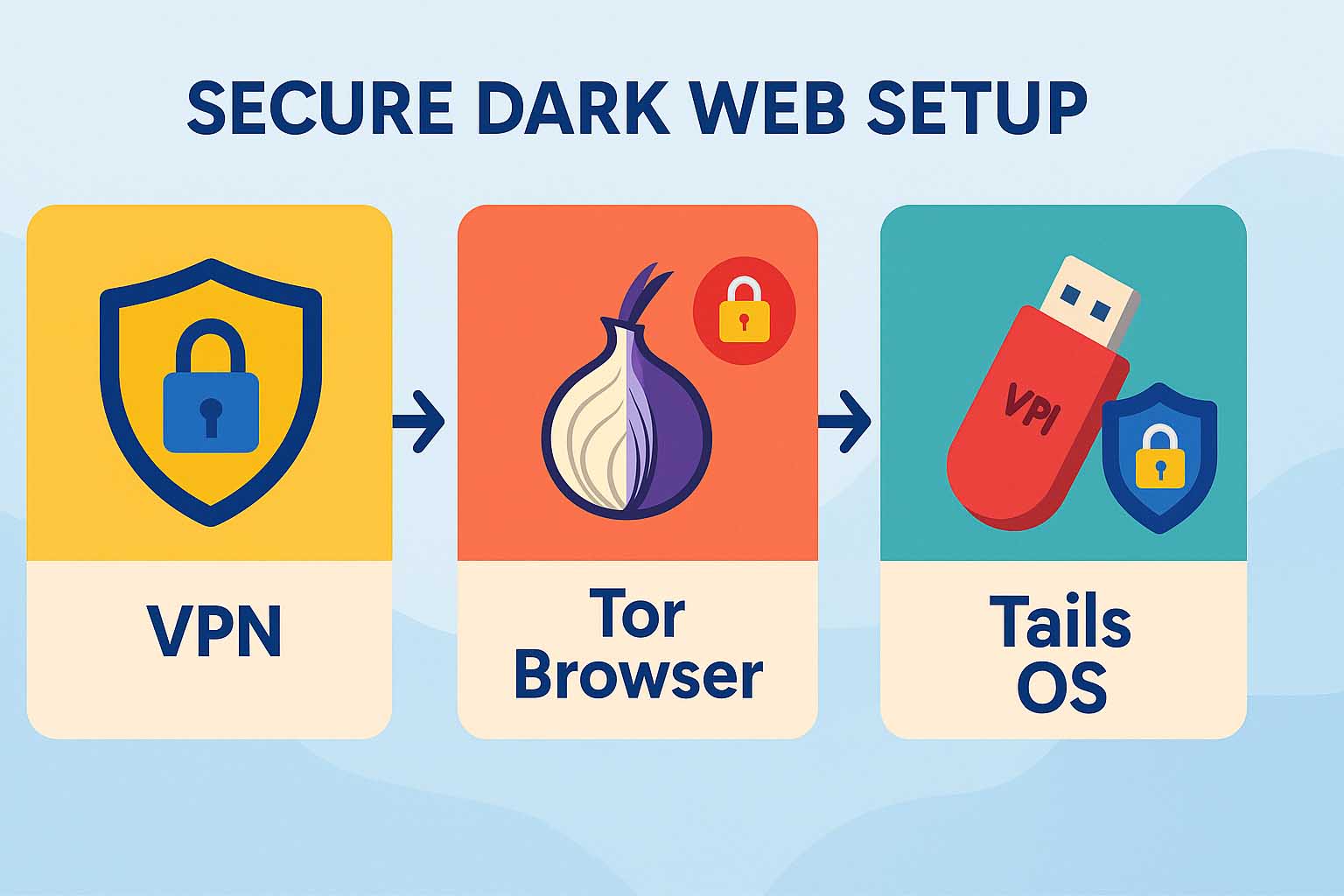
🔗 Top 12 Dark Web Sites and Verified Onion Links (2025)
Finding real and safe dark web links in 2025 is harder than it looks. Many directories are outdated or cloned, while others include malicious .onion addresses. That’s why we’ve hand-picked twelve trusted .onion sites that continue to provide value, privacy, and reliability. Each has been verified for uptime and authenticity. Remember to use the Tor Browser to access these, and always type the [dot]onion address carefully to avoid fakes.
Ahmia
Ahmia is one of the most respected dark web search engines available today. It filters out illegal and scammy content while indexing only verified .onion links. Built with privacy in mind, Ahmia lets users explore dark web sites without exposing them to risky or harmful pages. It’s ideal for first-time users and researchers looking for real, working .onion resources in a safer environment.
Ahmia is a great starting point and one of the only Ahmia onion search engine tools available via the clearnet.
Dread
Dread is a thriving Reddit-style forum dedicated to the dark web community. Users discuss everything from marketplace reviews to Tor security practices. What makes Dread trusted is its long-standing PGP-verifiable admin presence and active moderation against scams and phishing. It’s also hosted through resilient infrastructure to fight against DDoS attacks and frequent takedown attempts, helping it remain a reliable platform for uncensored discussion.
ProPublica (onion)
ProPublica made history by becoming one of the first major investigative journalism outlets to launch a .onion mirror. This version of their site allows readers in restrictive countries to access groundbreaking journalism without censorship or surveillance. It is identical to the surface web version in content but built with privacy in mind. The organization regularly maintains this onion version and lists the official address on its clearnet site for verification.
Hidden Wiki
The Hidden Wiki remains one of the most popular dark web directories, but it’s also the most frequently cloned. The original offers categorized .onion links, from forums to file-sharing tools. While many users begin their dark web journey here, caution is strongly advised. Only trust versions that are verified by uptime monitors or digitally signed by trusted sources to avoid dangerous clones full of fake sites and malware traps.
OnionLinks
OnionLinks is a curated dark web directory updated frequently with working .onion URLs. It categorizes links by function — markets, forums, search engines, privacy tools — and also includes uptime indicators. What sets it apart is its clean design and regular link testing, which reduces the chance of landing on broken or harmful pages. It’s a go-to for users who want structure and security in their dark web exploration.
SecureDrop
SecureDrop is a whistleblower submission system used by major newsrooms and independent journalists alike. Built specifically for the dark web, it allows sources to send confidential documents and messages anonymously. Every installation has its .onion link hosted by the respective publication. The platform is open-source, audited, and designed to protect both the sender and recipient. It’s a cornerstone of transparency and investigative reporting on the dark web.
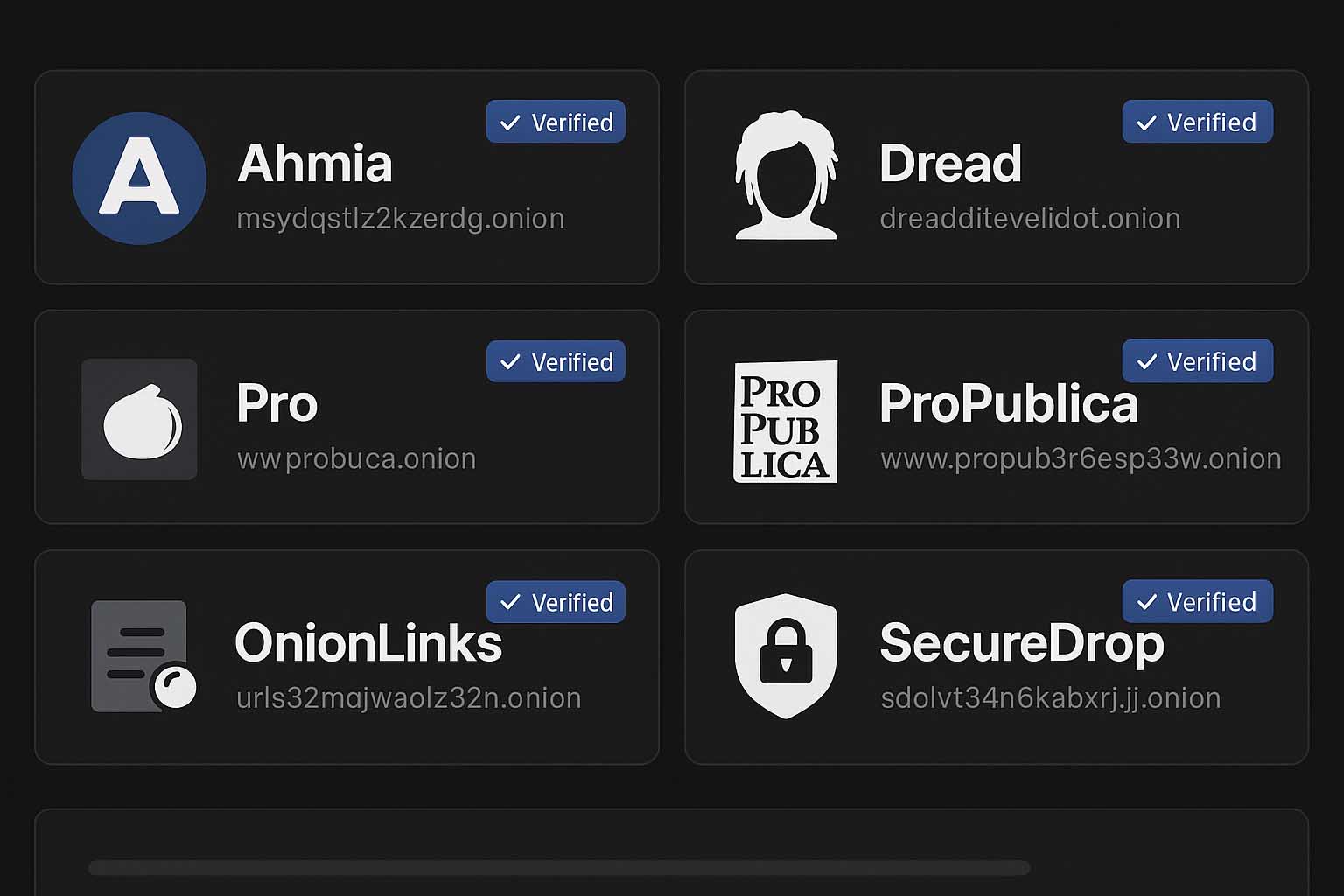
DarknetLive
DarknetLive is a trusted news site focused on the dark web. It reports on marketplace shutdowns, law enforcement takedowns, court proceedings, and major scams. Known for its speed and accuracy, DarknetLive often publishes verified information before mainstream outlets pick it up. It’s one of the few resources that consistently updates its .onion mirror, ensuring availability even during domain seizures or censorship events.
ZeroBin
ZeroBin is a paste tool that allows you to publish and share encrypted text anonymously. The tool is designed so that even the server cannot read the content you paste. It’s ideal for posting sensitive instructions, onion links, or short encrypted messages. Since it runs entirely in the browser with JavaScript, no plaintext is ever sent to the server. Many communities and individuals rely on it for safe, temporary sharing.
Haystak
Haystak is a specialized dark web search engine with one of the largest indexes of .onion domains. Unlike surface engines, Haystak offers deep crawling and metadata previews to help users navigate through hidden content. It also includes advanced filters and subscription options for research-level access. Due to its dedication to accuracy and privacy, Haystak is a favorite among journalists, academics, and threat analysts searching the dark web.
Mail2Tor or ProtonMail
For those needing secure and anonymous communication, Mail2Tor offers an .onion email interface that never logs IPs or metadata. While limited in features, it provides basic encrypted email functionality over the Tor network. Alternatively, ProtonMail maintains its .onion portal that mirrors the clearnet version, allowing users to send secure emails without leaving the anonymity of the Tor environment.
Tails OS Docs
The official Tails OS documentation is also accessible through an .onion mirror, offering users critical setup and usage guides directly over Tor. This is especially valuable for people in censorship-heavy regions or under surveillance. These docs walk users through secure browsing, file storage, and messaging practices, all while maintaining the integrity of anonymous operating environments. It’s an essential link for anyone serious about digital privacy.
Imperial Library
The Imperial Library is a hidden book repository filled with rare, controversial, and out-of-print materials that are hard to find elsewhere. It serves as an open-access digital archive with a focus on banned, historical, and suppressed works. Unlike typical libraries, it doesn’t track user behavior and offers .onion access to preserve reader privacy. It has earned its place as a respected underground knowledge vault.
🔍 How to Know If a Dark Web Link Is Real
With the rise in fake directories and phishing pages, knowing whether a dark web link is real has become more important than ever. A single wrong click could lead to a scam, malware infection, or even a stolen crypto wallet. Fortunately, there are trusted ways to verify whether a .onion link is legitimate.
First, check the link on directories like dark.fail or onion.live. These platforms monitor uptime and authenticity for many popular dark web sites, including forums, marketplaces, and directories. They list verified mirrors and often display digital PGP signatures posted by site administrators. These signatures are a powerful trust signal — they confirm the identity of the site’s operator and help you distinguish between real and fake versions.
One common tactic among scammers is URL spoofing — creating .onion addresses that look almost identical to trusted ones. For example, a fake version of the Hidden Wiki might use a URL like hiddenwik1[dot]onion that instead of the real one, swapping one character to mislead users. Because .onion addresses are made up of random-looking characters, it’s easy to fall for a slight variation.
Always double-check the spelling of a link and compare it against a trusted directory or the official announcement thread (if available on Dread or Reddit). Avoid clicking links posted on surface web comment sections or unverified forums. And never bookmark .onion links unless you’re sure they come from a trusted, PGP-signed source.
Caution, verification, and patience are your best defenses when navigating the dark web safely.
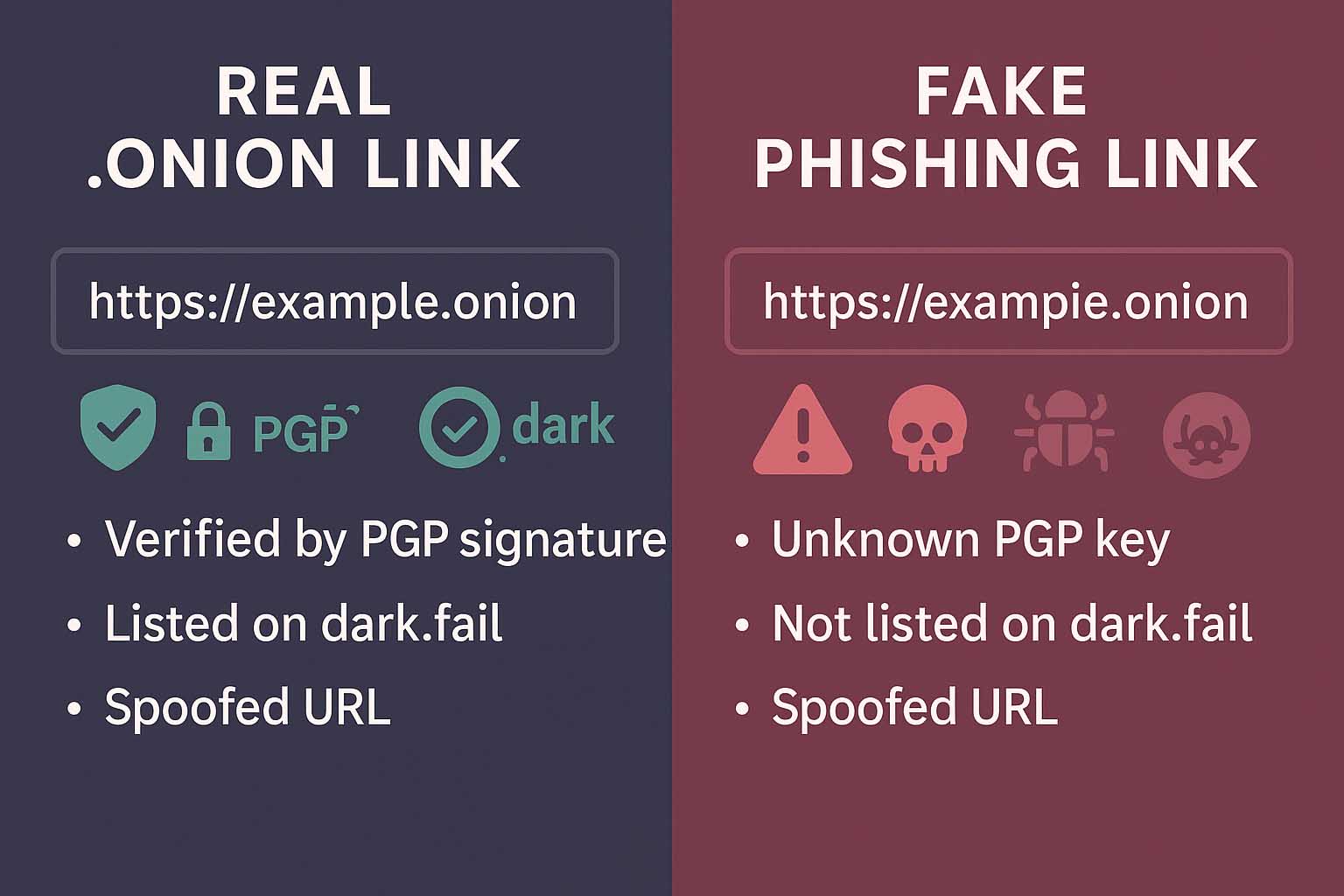
⚠️Fake Dark Web Sites to Avoid
The dark web may offer access to valuable resources, but it’s also filled with traps, especially fake dark web sites designed to scam or harm unsuspecting users. One of the most common threats in 2025 comes from fraudulent marketplaces. These sites are crafted to look like real, trusted markets, complete with product listings, vendor ratings, and support pages. But once you send cryptocurrency to fund your account or make a purchase, the funds vanish — and so does the site.
Even more dangerous are fake clones of legitimate services like SecureDrop. These clones mimic the design and purpose of the original, often going so far as to copy privacy statements and security warnings. But instead of protecting whistleblowers, these fakes are designed to collect sensitive documents or deanonymize users through malicious code.
Cloned versions of the Hidden Wiki are also everywhere. Many surface web results claiming to link to the “real” Hidden Wiki are actually trap sites. These often include links to malware-infected downloads, phishing sites, or scam forums. Some are so well-built that they appear trustworthy until it’s too late.
Avoiding these dangers means staying informed, sticking with trusted directories, and never trusting a .onion site just because it looks polished. On the dark web, appearance can be deceiving, and often, it’s designed that way on purpose.
🕶️Staying Anonymous on the Dark Web
Anonymity is one of the main reasons people explore dark web links, but it’s surprisingly easy to compromise your identity if you’re not careful. Many users make the mistake of using personal information out of habit, something that can instantly defeat the purpose of using the dark web in the first place.
Never log in to any dark web site using your real email address, especially one tied to your social media, banking, or everyday browsing. Instead, use a dark web-friendly email provider like ProtonMail’s .onion version or Mail2Tor. Better yet, create an alias specifically for browsing and never reuse it elsewhere.
Avoid using your real name or repeating patterns that can be traced back to you, such as favorite usernames, writing style, or posting schedule. Even small details, like the time of day you’re active, can be used to connect the dots between your real and anonymous identity.
Always double-check any link before clicking. Many phishing pages and malware traps are hidden behind .onion URLs that look almost identical to the real thing. Hovering isn’t possible on Tor like in normal browsers, so it’s crucial to verify links through directories like dark.fail or onion.live before you trust them.
On the dark web, anonymity is a fragile shield, and staying careful is the only way to keep it intact.
🗂️Categories of Dark Web Sites Explained
Not all dark web sites serve the same purpose. While many newcomers assume it’s all about illegal marketplaces, the reality is far more complex. Below are the main categories of dark web sites in 2025, along with examples of what users typically find in each.
Search Engines
Dark web search engines help users discover hidden .onion content that isn’t indexed by traditional search tools. Ahmia is the safest option, filtering illegal and harmful content while indexing verified sites. Torch is one of the oldest search engines on the dark web, offering a larger index but fewer filters, which means users must navigate with caution. Haystak offers a more advanced experience, including metadata previews and paid access to deep datasets. These engines are crucial for researchers and privacy advocates looking to explore the dark web beyond popular directories.
Forums & Communities
Forums remain central to dark web culture. Dread is the most active, functioning like a Reddit-style message board where users discuss everything from Tor security to reviews of dark web services. It’s known for strong moderation and PGP-signed announcements. Hidden Answers, on the other hand, is more like a dark web version of Quora. It allows anonymous users to ask and answer questions on controversial or privacy-sensitive topics. Both are valuable for learning and exchanging ideas without revealing identity.
Marketplaces
Dark web marketplaces are hubs where vendors sell everything from digital tools to physical goods. While some of these markets operate legally within certain jurisdictions, many are known for illegal activity. For this reason, they are often short-lived and heavily targeted by law enforcement. Users should be extremely cautious when exploring this category, as fake markets and scams are widespread. No marketplace should ever be trusted blindly, even if it looks professional.
News & Whistleblowing
Dark web platforms focused on news and transparency include ProPublica’s onion mirror, which delivers investigative journalism free from surveillance or censorship. It’s identical to the clearnet version but accessible via Tor. SecureDrop, meanwhile, enables whistleblowers to send files to journalists anonymously and securely. These platforms are trusted by activists, reporters, and individuals in oppressive regimes who need to share sensitive information safely.
Tools & Hosting
Privacy tools are essential on the dark web. ZeroBin allows users to post encrypted text that even the host server can’t read — perfect for pasting links or messages securely. OnionShare lets users share files directly from their device over a temporary .onion address without needing a centralized server. These tools are open-source, regularly audited, and trusted by privacy communities around the world.
Email & Communication
Secure communication is a priority on the dark web. ProtonMail offers a .onion version of its encrypted email service, giving users end-to-end privacy with access through Tor. Mail2Tor is a more anonymous option, offering a simple inbox interface without storing logs or metadata. These services are ideal for exchanging messages without exposing your identity, whether you’re speaking to journalists, forums, or personal contacts in high-surveillance regions.
🧭The Hidden Wiki – Still Useful or Too Risky in 2025?
The Hidden Wiki has long been one of the most recognizable entry points into the dark web. It began as a simple, categorized directory of .onion links — helping new users find forums, search engines, whistleblowing tools, and more. Back when reliable dark web search engines were limited, the Hidden Wiki served as a trusted compass for exploring the hidden layers of the internet.
However, over the years, the Hidden Wiki name has become controversial. Because it’s such a well-known brand, countless clones and fake versions have appeared across both the surface web and the Tor network. These copies often contain outdated links, dangerous redirects, or even malware-laced pages. Some are created purely to trick users into clicking harmful or phishing links under the illusion of legitimacy.
Despite these risks, the Hidden Wiki can still be a powerful and valuable resource — if used correctly. Always ensure you’re on the real version, like the one you’re reading now. This site is updated regularly, checked for authenticity, and maintained with user safety in mind. If you ever land on a Hidden Wiki version with suspicious design, aggressive pop-ups, or broken links, treat it as a red flag and exit immediately.
“If you’re completely new, start with this Hidden Wiki beginner’s guide to understand how it works before browsing.
Use the Hidden Wiki as a starting point, not an endpoint. Cross-check onion links with trusted directories like dark.fail or onion.live, and never follow a link blindly. With the right precautions, the Hidden Wiki in 2025 remains one of the most helpful tools for navigating the dark web — and yes, you’re in the right place.
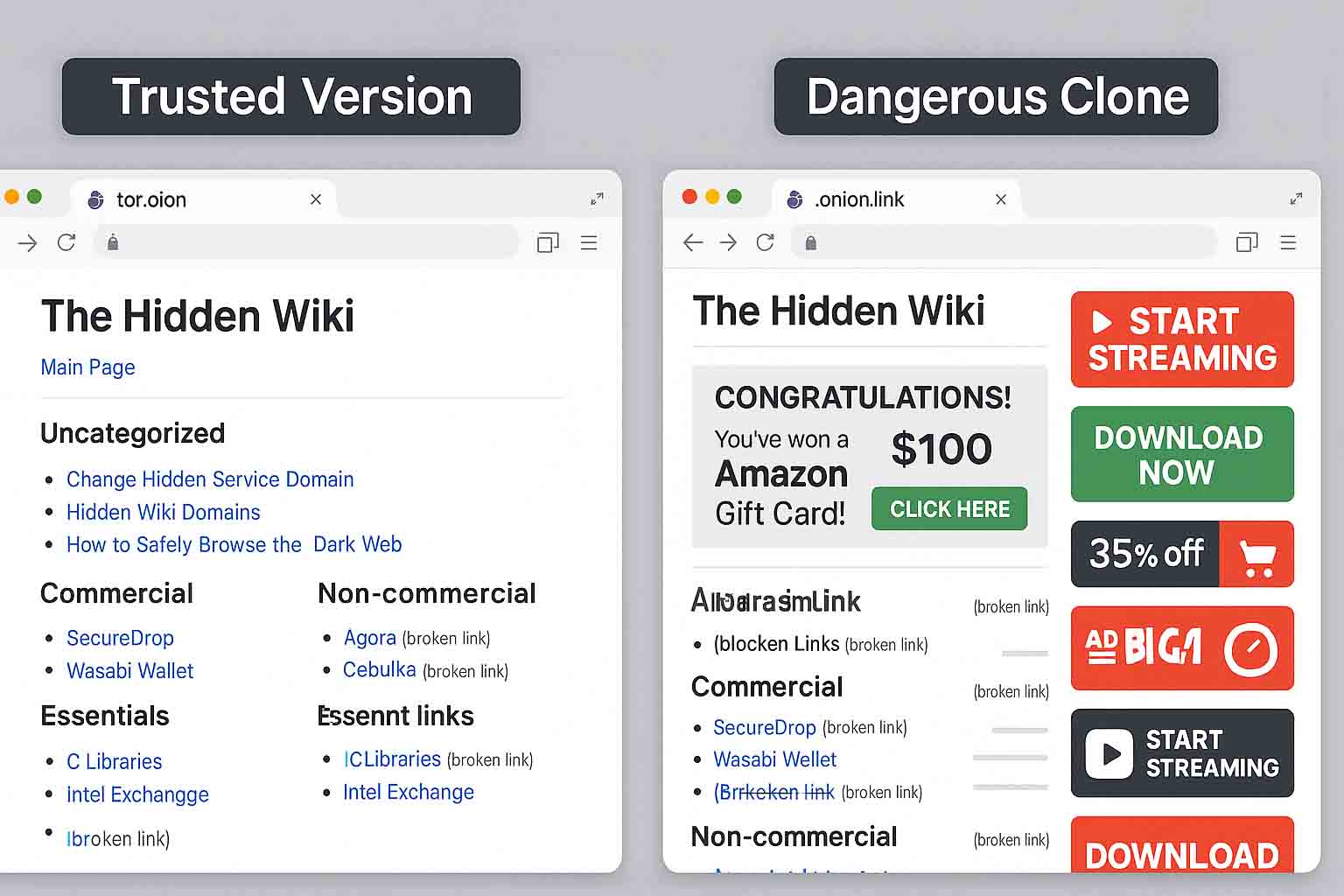
✅Final Thoughts – Stick to Known, Safe Directories
The dark web offers real value for those seeking privacy, uncensored information, or freedom from surveillance. But to explore it safely, you need to be selective. Not every dark web link is trustworthy. Even a single wrong character in a .onion A URL can lead to scams, malware, or fake marketplaces. That’s why relying on trusted onion directories like Ahmia, Dark.Fail, OnionLinks — and the real Hidden Wiki — are essential.
These directories do more than just list addresses. They help users find real dark web links, verify them through uptime tracking, and avoid dangerous clones. Whether you’re browsing out of curiosity or pursuing sensitive research, using dark web sites that are safe in 2025 is a matter of both security and responsibility.
Here at hidden.wiki, we’ve made it our mission to keep this version accurate, current, and user-friendly. It’s your launchpad — a guide for exploring the rest of the dark web. But remember: caution shouldn’t stop here. Always verify links. Use tools like the Tor Browser, a VPN, and privacy-first email providers. Never assume a site is safe just because it looks professional.
The dark web in 2025 still holds power, but only for users who browse smartly. Stick to verified directories, question everything, and always put your privacy first.

